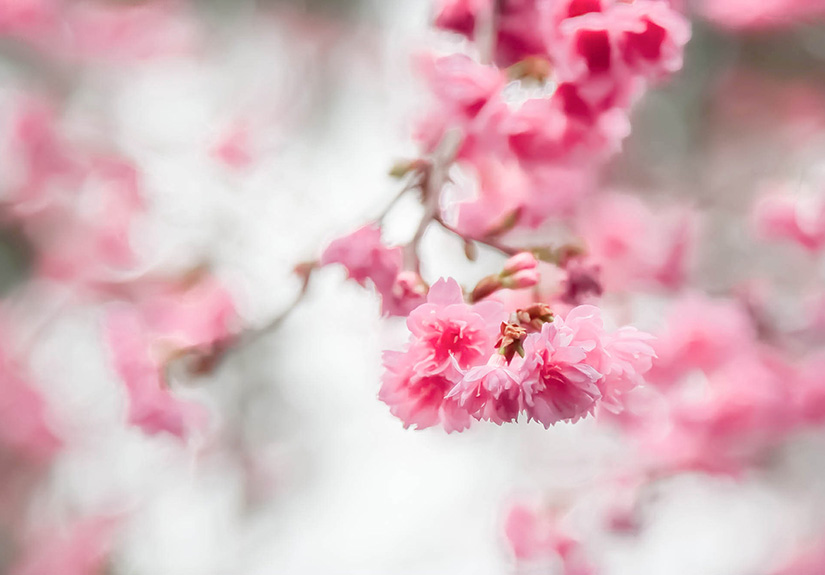Shooting Tips for Spring Sakura
Sakura (cherry blossoms) is undoubtedly one of the most beautiful spring flowers. Every year from March to April, sakura is in full blossom in different regions in Japan. In this article, we will share various shooting techniques and tips to help you capture the best of sakura.
Macro Shots to Show the Details
Sakura is relatively small in size. If you want to take a feature shot of it or its pistils, a macro lens should be used. As a higher magnification will result in shallower depth of field, we should set the focus to single-point AF or spot AF for more accurate result. In general, we should focus on the pistils. If the depth of field is still too shallow and the petals get blurry, we can use a smaller aperture such as f/8.
Regarding the composition, we should carefully frame so that the pistils on the front will not overlap those behind. We can also try shooting from above to capture the whole flower. Keep the background as clean as possible and leave space. Weather and time can make a big difference to your images too. In the morning or after rain, flower with dew drops is absolutely stunning. We can also try taking a macro shot on the pistils only for more one-of-a-kind result.
Regarding the composition, we should carefully frame so that the pistils on the front will not overlap those behind. We can also try shooting from above to capture the whole flower. Keep the background as clean as possible and leave space. Weather and time can make a big difference to your images too. In the morning or after rain, flower with dew drops is absolutely stunning. We can also try taking a macro shot on the pistils only for more one-of-a-kind result.

EOS 5D Mark II • EF 100mm f/2.8L Macro IS USM • f/5.6 • 1/320s • ISO 1000
Sea of Flowers with Wide-Angle
One of the reasons that make Japanese sakura so famous is the ample quantity. Sakura trees lining up along both sides of a road is a common scene in Japan, and it is absolutely spectacular when some of the flowers fall. With an ultra wide-angle lens, we can capture the magnificent scene of sakura blossoms from a wide perspective. Use the wide end of a standard lens if you don’t have an ultra wide-angle lens.
Regarding the composition, we usually position the sakura on both sides of the frame, and complement its beauty with objects that reflect local cultures such as train, car, building or people in the middle. We can also try capturing the lines of sakura trees from the top of a hill. Use a smaller aperture such as f/8 to ensure adequate depth of field. If we are shooting with a blue sky as background, use a circular polarizing filter to enhance the color saturation. Turn the filter and observe the changes in colors in the viewfinder. This can result in photos with a bluer sky and more vivid flower colors.
Regarding the composition, we usually position the sakura on both sides of the frame, and complement its beauty with objects that reflect local cultures such as train, car, building or people in the middle. We can also try capturing the lines of sakura trees from the top of a hill. Use a smaller aperture such as f/8 to ensure adequate depth of field. If we are shooting with a blue sky as background, use a circular polarizing filter to enhance the color saturation. Turn the filter and observe the changes in colors in the viewfinder. This can result in photos with a bluer sky and more vivid flower colors.

Apart from shooting the sakura alone, we can include different shades of colors in the photo for more spectacular result.
Title:《昭和賞櫻》 Club Canon會員:Wong Suk Ha
EOS 550D • EF-S 17-55mm f/2.8 IS USM • f/8 • 1/400s • ISO 200
Title:《昭和賞櫻》 Club Canon會員:Wong Suk Ha
EOS 550D • EF-S 17-55mm f/2.8 IS USM • f/8 • 1/400s • ISO 200
Separate the Subject from a Blurry Background
Various focal lengths from standard to telephoto can be used to capture the beautiful shape and form of sakura. Telephoto zoom lenses covering 70-200mm or 70-300mm are nice options that provide versatile usages. For more apparent out-of-focus effect, or to make the most beautiful flower stand out from the rest, we should use a large aperture prime lens instead, such as the EF 50mm f/1.4 USM . The extremely shallow depth of field made possible by a large aperture can outstand the beauty of flower. We can follow the golden ratio and position the subject flower on either the left or right hand side of the frame. Leave some space and make sure there is certain distance between your subject flower and the background flowers. By blurring the background with a large aperture lens, we can achieve photo that shows depth with an obvious subject. Also pay attention to the direction of light. When shooting a backlit subject, increase the exposure compensation by at least 1 stop.

When taking feature shot of sakura, we can make use of the characteristics of a large aperture to blur the background so that the subject can stand out.
Title:《櫻。賞》 Club Canon會員:Chau Ka Wai
EOS 500D • EF 50mm f/1.4 USM • f/4.5 • 1/200s • ISO 200
Title:《櫻。賞》 Club Canon會員:Chau Ka Wai
EOS 500D • EF 50mm f/1.4 USM • f/4.5 • 1/200s • ISO 200
Nighttime Shooting
Apart from shooting in the sunlight, nighttime shots of sakura show a different expression but are more difficult to capture. First, look out for sakura that is brightly lit. Since the light source is weaker than in daytime, we should use a higher ISO setting such as ISO 1600 or above in order to keep the photos in clarity. Lens with a large aperture and image stabilization function like the EF 70-200mm f/2.8L IS II USM makes shooting easier as it can allow more light to enter than those zoom lenses with variable aperture. The large aperture can also turn the light source in the background into beautiful bokeh to create a dreamy effect. Besides, we can also use a tripod for enhanced stability. However, even if the camera is steady enough, the exposure time should not be too long as we may end up with a blurry photo when the sakura moves in the wind.
The color of the photo mainly depends on the light source. For example, you will have a sakura photo in purple if the light source is purple. For more creative results, we can use different white balance settings to change the colors deliberately. On the contrary, to capture the original color of sakura, we can first take a shot of a piece of white paper in front of the sakura, and then adjust to the custom white balance to capture the faithful color.
The color of the photo mainly depends on the light source. For example, you will have a sakura photo in purple if the light source is purple. For more creative results, we can use different white balance settings to change the colors deliberately. On the contrary, to capture the original color of sakura, we can first take a shot of a piece of white paper in front of the sakura, and then adjust to the custom white balance to capture the faithful color.

When shooting sakura in the night, we should pay attention to the light source in addition to the color. With a large aperture telephoto lens, we can create beautiful bokeh in the background.
Title:《沖繩夜櫻》 Club Canon會員:TSUI SHI KI
EOS 6D • EF 70-200mm f/2.8L IS USM • f/2.8 • 1/125s • ISO 1600
Title:《沖繩夜櫻》 Club Canon會員:TSUI SHI KI
EOS 6D • EF 70-200mm f/2.8L IS USM • f/2.8 • 1/125s • ISO 1600
The People Element
Apart from the normal ways to take pictures of sakura, we can also add the element of people in the photos to tell a story. For example, the facial expressions of the people viewing the flowers would be a good touch up. We can use a telephoto lens to create a sense of compression in the composition, and pick a location where the sakura is densely grown as background. Frame a shot so that the people in the photo only take up a small proportion, as our aim is to create a story-telling photo with the use of the expressions or gestures of people. Pay attention to the shutter speed when taking photos with people. As a telephoto lens is used and the people may move around, we should use at least the safe shutter speed to freeze the moment. For example, for a 200mm lens, the safe shutter speed would be 1/200s or faster.

Although this photo didn’t capture the expressions of the girls, the way they walked under the densely
Title:《追 • 櫻吹雪》 Club Canon會員:Tam Tsz Yeung
EOS 5D Mark III • EF 70-200mm f/4L IS USM • f/4.5 • 1/125s • ISO 800
Title:《追 • 櫻吹雪》 Club Canon會員:Tam Tsz Yeung
EOS 5D Mark III • EF 70-200mm f/4L IS USM • f/4.5 • 1/125s • ISO 800
Stay Tuned on the Forecast
Despite that the weather is ever changing, the sakura blossom forecast schedule is rather reliable. Before buying a flight ticket, check if there is any update on the blossom forecast schedule at the official website of Japan Weather Association. In general, sakura blossom starts from Southern Japan and goes all the way to Northern Japan. Visit http://www.tenki.jp/sakura for more information.
Other countries besides Japan are also good spots to view cherry blossoms, such as Wuhan University, East Lake Cherry Blossom Garden, Yuyuantan Park in Beijing and Qingdao Zhongshan Park. In Korea, we can go to Hallasan and Jeju National University in Jeju, Jinhae in Busan and Yeouido in Seoul for cherry blossoms that last from late mid March till early May.
Other countries besides Japan are also good spots to view cherry blossoms, such as Wuhan University, East Lake Cherry Blossom Garden, Yuyuantan Park in Beijing and Qingdao Zhongshan Park. In Korea, we can go to Hallasan and Jeju National University in Jeju, Jinhae in Busan and Yeouido in Seoul for cherry blossoms that last from late mid March till early May.



